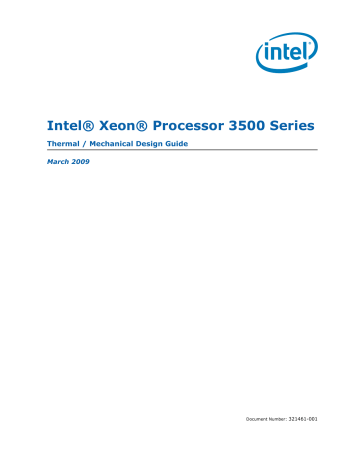- Computers & electronics
- Computer components
- System components
- Processors
- Intel
- Xeon 3500 Series
- User manual
advertisement

Figure 5-3. Thermal solution Performance
Sensor Based Thermal Specification Design Guidance
5.3
5.3.1
Thermal Solution Design Process
Thermal solution design guidance for this specification is the same as with previous products. The initial design must take into account the target market and overall product requirements for the system. This can be broken down into several steps:
• Boundary condition definition
• Thermal design / modelling
• Thermal testing
Boundary Condition Definition
Using the knowledge of the system boundary conditions (e.g., inlet air temperature, acoustic requirements, cost, design for manufacturing, package and socket mechanical specifications and chassis environmental test limits) the designer can make informed thermal solution design decisions.
The thermal boundary conditions for an ATX tower system are as follows:
• T
EXTERNAL
= 35 °C. This is typical of a maximum system operating environment
• T
RISE
= 4 °C. This is typical of a chassis compliant to CAG 1.1
• T
AMBIENT
= 39 °C (T
AMBIENT
= T
EXTERNAL
+ T
RISE
)
Based on the system boundary conditions, the designer can select a T to use in thermal modelling. The assumption of a T
AMBIENT
AMBIENT
and Ψ
CA
has a significant impact on the required Ψ assumed T
CA
needed to meet TTV T
CASEMAX at TDP. A system that can deliver lower
AMBIENT
can utilize a design with a higher Ψ
CA
, which can have a lower cost.
Figure 5-4 shows a number of satisfactory solutions for the processor.
30 Thermal/Mechanical Design Guide
advertisement
* Your assessment is very important for improving the workof artificial intelligence, which forms the content of this project
Related manuals
advertisement
Table of contents
- 7 Introduction
- 8 References
- 8 Definition of Terms
- 11 LGA1366 Socket
- 13 Board Layout
- 14 Attachment to Motherboard
- 14 Socket Components
- 14 Socket Body Housing
- 14 Solder Balls
- 15 Contacts
- 15 Pick and Place Cover
- 16 Package Installation / Removal
- 16 Socket Standoffs and Package Seating Plane
- 17 Durability
- 17 Markings
- 17 Component Insertion Forces
- 17 Socket Size
- 18 LGA1366 Socket NCTF Solder Joints
- 19 Independent Loading Mechanism (ILM)
- 19 Design Concept
- 19 ILM Cover Assembly Design Overview
- 20 ILM Back Plate Design Overview
- 20 Assembly of ILM to a Motherboard
- 23 Component Mass
- 23 Package/Socket Stackup Height
- 23 Socket Maximum Temperature
- 24 Loading Specifications
- 24 Electrical Requirements
- 25 Environmental Requirements
- 27 Sensor Based Thermal Specification Design Guidance
- 27 Sensor Based Specification Overview
- 28 Sensor Based Thermal Specification
- 28 TTV Thermal Profile
- 29 Specification When DTS value is Greater than TCONTROL
- 30 Thermal Solution Design Process
- 30 Boundary Condition Definition
- 31 Thermal Design and Modelling
- 32 Thermal Solution Validation
- 33 Fan Speed Control (FSC) Design Process
- 34 Fan Speed Control Algorithm without TAMBIENT Data
- 35 Fan Speed Control Algorithm with TAMBIENT Data
- 36 System Validation
- 37 Specification for Operation Where Digital Thermal Sensor Exceeds TCONTROL
- 39 ATX Reference Thermal Solution
- 39 Operating Environment
- 40 Heatsink Thermal Solution Assembly
- 41 Reference ATX Thermal Mechanical Design
- 42 Reference Design Components